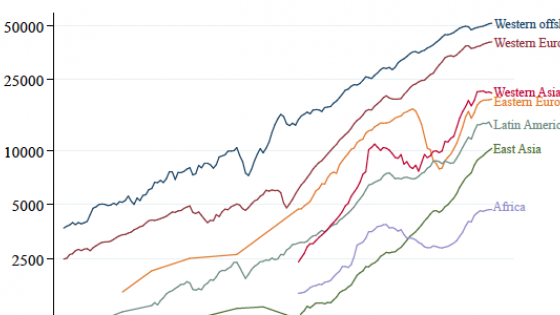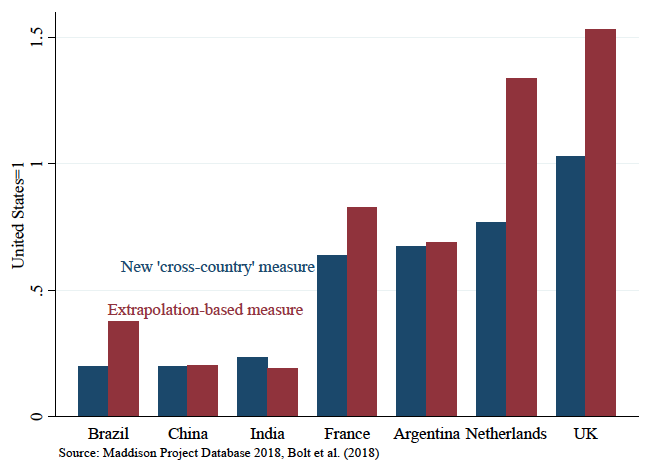The process of modern economic growth started approximately 200 years ago in several frontier economies, in western Europe and North America (Jones 2016). So, to understand why some countries are much richer than others, a long-term perspective is essential.
The main divergence in income levels across countries occurred well before statisticians started to systematically monitor the size and growth of the economy. Angus Maddison (1995, 2001, 2007) was enormously influential in shaping our view of long-run economic development. He provided a comprehensive view of real GDP per capita across countries and over time, using disparate historical and modern sources of information. Maddison's real GDP per capita numbers are based on one cross-country income comparison (most recently for 1990). This is extrapolated backwards using estimates of GDP growth from historical national accounts and other sources.
Maddison aimed to capture both growth over time and relative levels across countries in the same time series. But direct measurements of relative income levels in the 19th and early 20th century often diverge from Maddison’s estimates (Lindert and Williamson 2016, Ward and Devereux 2018). Research on the different ways to compare present-day income show that measures of growth and income levels differ conceptually, and in practice (Deaton and Aten 2017, Inklaar and Rao 2017). This implies that that forcing a single data series to serve two purposes distorts either patterns of growth, patterns of comparative income levels, or both. Moreover, these distortions tend to grow over time. We urgently need a new approach to Maddison’s historical statistics.
A new measurement approach
In recent work (Bolt et al. 2018), we introduce a new version of the Maddison Project Database (www.ggdc.net/maddison), in which we use two separate measures of real GDP per capita:
- A ‘cross country’ measure. This is designed to best capture comparative income levels across countries. It relies on all available data and research on these comparisons, from modern purchasing power parities compiled by the International Comparison Program (ICP) at the World Bank (http://icp.worldbank.org) to historical work on comparative income levels in the 19th and early 20th century.
- A ‘growth’ measure. This is designed to best capture growth of GDP per capita over time. It combines modern national accounts data with state-of-the-art reconstructions of GDP growth in history.
Further back in time, cross-country income comparisons become scarcer, so we follow the approach taken in the Penn World Table since version 8.0 (Feenstra et al. 2015). At these times, our ‘cross-country’ measure of real GDP is based on a direct observation of comparative income at a point in time, interpolation between direct observations, or extrapolation from the first or last direct observation using the ‘growth’ measure of real GDP per capita.
New data, new insights
Compared to the traditional Maddison method of extrapolation from a single, modern-day observation, the new ‘cross-country’ measure gives substantially different relative income levels. Figure 1 illustrates this for several countries.
Figure 1 Real GDP per capita in 1870 (US = 1)
Source: Maddison Project Database 2018, Bolt et al. (2018).
The figure compares the level of real GDP per capita relative to the US for the year 1870 based on the new ‘cross-country’ measure and on an extrapolation-based measure. The extrapolation-based measure suggests that the UK and the Netherlands had substantially higher income levels than the US, but the new measure shows that the UK and US were at similar levels, and the Netherlands was much closer to France.
The figure also shows that the difference between the two measures varies considerably across countries, with hardly any difference for Argentina or China, a lower comparative level for Brazil, and a higher comparative level for India.
The Maddison database provides data for the period before 1870 as well, but for nearly all countries we have information only on the growth of GDP per capita in each country. This is used to extrapolate backwards from the first direct observation of cross-country income levels. As a result, the difference between the ‘cross-country’ measure and this extrapolation-based measure remains constant in this earlier period. We can provide further anchors for our ‘cross-country’ measure when historical research provides earlier direct observations.
Using our new measure of comparative income levels, we can exploit the breadth of the Maddison data to chart economic development since 1870 across broad regions of the world. The new data, in Figure 2, show that the region named ‘Western Offshoots’, which is dominated by the US, had the highest income throughout the period. It also shows that the income difference with the next richest region, western Europe, was at its peak in 1950, following WWII.
Figure 2 Average real GDP per capita across regions, 1870-2016
Source: Maddison Project Database 2018, Bolt et al. (2018).
The relative income level in Western Europe fluctuated between 60% and 70% of the US level between 1870 and 1914. It attained a similar relative level around 1970. Finally, the figure emphasises the large gap in income levels between Western Europe and Western Offshoots, and the rest of the world. For Eastern Europe, movement towards the frontier does not start until 1930. In other regions, this process starts much later.
The new Maddison Project Database gives us a more systematic way to analyse other questions which require long-term data on GDP per capita:
- Cross-country income convergence. Barro (2015) argued that long-term series are necessary to estimate the rate of convergence reliably. Existing data suggest a 2% rate of convergence; our new ‘cross-country’ measure supports this convergence rate, but is estimated much more reliably. This suggests that income convergence has had a smaller measurement error than the ‘growth’ measure.
- Price-income relationship. The finding that price levels are generally higher in higher-income countries is a strong empirical regularity (Feenstra et al. 2015). This has typically been explained using the Balassa-Samuelson hypothesis, that productivity in the non-traded sector differs less between high- and low-income countries than productivity in the traded sector. We are able to show that price levels implied by extrapolated real GDP per capita figures tend to fit the modern price-income relationship much less clearly than the direct relative price observations.
Separate series for different applications
It has been known for a long time that historical cross-country income comparisons have been inconsistent with measures of growth between these comparisons. Maddison (1995) blamed inconsistencies on measurement errors in cross-country comparisons, and explicitly chose to give greater credence to growth rate series. Yet even in situations in which measurement errors have been reduced as far as possible, inconsistencies remain, and – for good conceptual reasons – will remain important in the future (Deaton and Aten 2017).
There are also situations in which data on economic growth can be highly unreliable. These situations include (world) wars, times of political instability, weak statistical systems and periods of high inflation. Relying on a single, recent, cross-country comparison means that errors in growth rates can accumulate for decades, or centuries.
Even though we are not able to account fully for the differences between our new ‘cross-country’ measure and extrapolation-based measures of real GDP per capita, we conclude that it is important to present them as separate series and clearly indicate which series would be more appropriate in different applications.
We also hope that our approach will stimulate new research. The Maddison Project was created as a platform for researchers interested in economic performance around the world, and its database has been a useful way to share research on historical economic growth with the profession in a unified form. With this approach we aim to give similar prominence to research on comparative income levels, so we can enrich and improve our understanding of long-run economic development.
References
Barro, R J (2015), “Convergence and modernization” Economic Journal 125: 911–942.
Bolt, J, R Inklaar, H J de Jong and J L van Zanden (2018), “Rebasing ‘Maddison’: New income comparisons and the shape of long-run economic development”, GGDC Research Memorandum, no. 174.
Deaton, A and B Aten (2017), “Trying to Understand the PPPs in ICP 2011: Why Are the Results So Different?”, American Economic Journal: Macroeconomics 9(1): 243–264.
Feenstra, R C, R Inklaar and M P Timmer (2015), “The Next Generation of the Penn World Table”, American Economic Review 105(10): 3150–3182.
Inklaar, R and D S P Rao (2017), “Cross-Country Income Levels over Time: Did the Developing World Suddenly Become Much Richer?”, American Economic Journal: Macroeconomics 9(1): 265–290.
Jones, C I (2016), “The Facts of Economic Growth”, in J B Taylor and H Uhlig (eds.) Handbook of Macroeconomics Volume 2: 3–69.
Lindert, P H and J G Williamson (2016), “Unequal gains: American growth and inequality since 1700”, VoxEU.org, 16 June.
Maddison, A (1995), Monitoring the World Economy 1820–1992, OECD.
Maddison, A (2001), The World Economy: a Millennial Perspective, OECD.
Maddison, A (2007), Contours of the World Economy, 1-2030 AD, Oxford University Press.
Ward, M and J Devereux (2018), “New Perspectives on Productivity and Living Standards in the late 19th century” Maddison Project Working Papers, no. 9.








